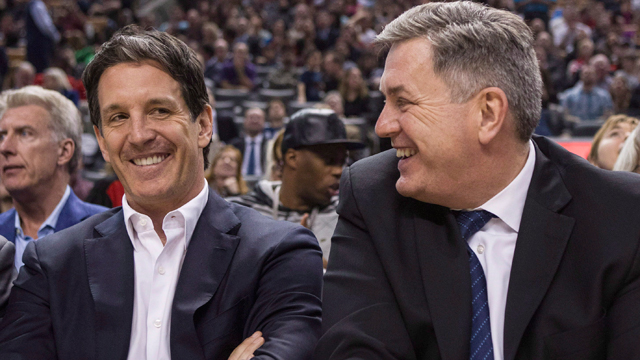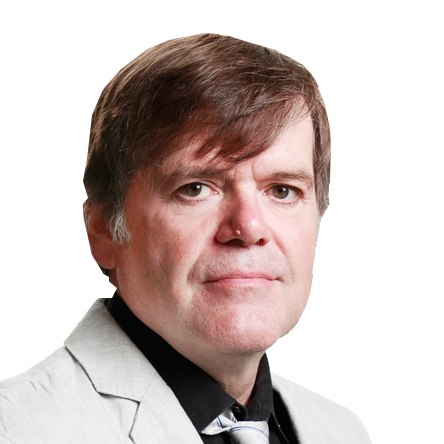Sports fans live for “comparables.” They yearn for easily digestible context. Thus when Brendan Shanahan was named president of the Toronto Maple Leafs this week, people sought out an analogous appointment, someone in the Shanahan mold.
But put it this way: Shanahan once scored more than 50 goals and recorded more than 200 penalty minutes in a season. The comparables on that count are fairly limited to Cam Neely and your fantasy-league dream come true. Having dealt with him over the past 20 years, I’d suggest that Shanahan off the ice and in retirement is every bit as rare. He has always managed by choice or simple involuntary force of personality to separate himself from the crowd.
In seeking out a comparable appointment to Shanahan’s this week, some tried to connect the dots between the new Leafs prez and the new guy in Vancouver, Trevor Linden. The timing of their hirings would be just about the only thing that should prompt comparisons. True, both shared a level of activism beyond the traditional parameters of leadership. Linden was more active in the NHLPA than any other member over the course of his career. Shanahan went Linden one better: Back during the season that wasn’t, the 2004-05 lockout, he convened a summit bringing together not just NHL players, but also executives and owners to discuss how the game might be improved.
Nonetheless, Linden’s and Shanahan’s installations are fundamentally different.
For more than a generation now, Linden has been considered a local treasure in Vancouver. The team named him captain at age 21 and he put in years of solid service. Even when his career was winding down and he headed off to the Islanders, the Canadiens and Washington, Canucks fans thought of him as their own. To them, it seemed like it would only be a matter of time before he returned to Vancouver and eventually set about assembling a team comprised of 20 or so players in his image.
While Shanahan might be the most famous son of Mimico, Ont., he never played for the Leafs. Sure, he understands the market having grown up in it, but his connection to Toronto doesn’t run deeper. He has family in Toronto, but hasn’t lived there for years. And he only passed through when he was logging hours doing video review down in the NHL’s Toronto offices, which qualifies him as a business tourist. It doesn’t feel quite as strange as, say, Ken Dryden parachuting in like he did back in the mid-90s. Still, if you saw this coming, six months or a year ago, let me know if you have any stock tips.
So let’s set aside Linden and look for another comparable for the new Leaf president. An obvious one can be found with an exec whose career intersected with Shanahan’s: Steve Yzerman, GM of the Tampa Bay Lightning. Yes, the guy who raised the Stanley Cup before Shanahan when the Wings won it in ’97, ’98 and 2002.
This is true of both of them as players: They stepped into the NHL at 18, stayed more than two decades, won an Olympic gold and were named to the Hockey Hall of Fame.
This is true of both of them as executives: They were recruited by franchises they never played for, knew they were taking on mismanaged teams that had endured almost comic struggles in recent seasons and report to Leiwekes. (Yzerman as GM reports to a CEO Tod Leiweke, who happens to be the younger brother of the MLSE potentate who tapped Shanahan for the president’s job.)
Now, you can suggest that just by title there’s a large gap between Shanahan, the prez, and Yzerman, the GM. Still, it’s impossible to imagine the younger Leiweke or anyone else in the Lightning’s executive command questioning a hockey judgment made by Yzerman. The same can be said of Shanahan, up a level and also down: The current and clearly embattled GM Dave Nonis—or anyone who might be appointed in his wake—will be working from Shanahan’s playbook.
So let’s say that this is the best comparable available. Is it good news for Leafs fans?
Yes, Yzerman made what looks like a great hire in coach Jon Cooper. He also made a couple of winning trades, the best converting an undrafted free agent rookie, Cory Conacher, into No. 1 netminder Ben Bishop. But his term in Tampa is open to interpretation. He was able to coax Guy Boucher, then the hottest coaching prospect in hockey, to pass over other teams and take the Lightning job. In his rookie season, Boucher was able to get his team within a game of the Stanley Cup final. His inspirational speeches didn’t have any staying power, though, and he was fired early in his third season. And that wasn’t the only misstep. Yzerman couldn’t re-engage Vincent Lecavalier and eventually cut his losses. And just when the team was in the midst of a breakthrough this winter, Martin St Louis, the Lightning’s true leader, took Yzerman’s decision not to name him to the Canadian Olympic team as a personal affront.
The sum of all this has been, if not a categorical success, enough to get Yzerman’s contract extended. Not a bad measure of a pass-fail.
There would be a school of thought contending that Yzerman moved into his position better prepared than Shanahan has with the Leafs. Much has been made of the four years that Yzerman put in as a vice-president in the Red Wings organization. For a would-be NHL exec you couldn’t ask for better on-the-job management training. Working with a crew of pro and amateur scouts, and minor-league player development staff, Yzerman seems to enjoy some advantages in experience when compared to Shanahan. But consider how very different their experiences as players were.
Yzerman famously played for the Wings from the start to the finish of his career. There were a few tumultuous seasons at the beginning, but from the early ’90s the franchise was a model of consistency on the ice, behind the bench and in the front office. The Wings could make subtle additions and deletions from year to year, a core of elite talent always in place. Maintenance but no tear downs, no rebuilds.
Shanahan played for six teams and 13 coaches. (We’ll count the two games with Paul Maurice in Hartford.) Suffice to say that Shanahan experienced many more varying franchise “cultures”—to borrow Tim Leiweke’s mot du jour—than did Yzerman. Shanahan knows how the culture of a championship team in Detroit differs from the culture of a train wreck teams like those in New Jersey and Hartford early in his career.
Shanahan would have also played with hundreds of teammates, probably a multiple of those who passed through the Wings organization during Yzerman’s tenure. That’s not saying that inside knowledge of these players counts as much on its own in assembling a roster—few would be kicking around these days. Nonetheless, Shanahan’s network as a player would be far bigger than Yzerman’s. Then factor in the players and execs he has worked with while heading up the NHL disciplinary department. When Yzerman stepped into his job in Tampa, he was doing business with people he was meeting for the first time. Shanahan knows them. If you don’t think that’s meaningful, then you’re assuming that the NHL is unlike absolutely any other business, sports or otherwise.
What’s more, Shanahan is by nature a wholly social animal. You’d have come away with a distinctly different impression at the presser introducing Shanahan as president. He handled every question as if it were wired with dynamite. On his introduction he opted to take a tack opposite to that of his good friend Brian Burke who boldly entered Leafs Nation, acted too quickly and was mocked for throughout tenure. For Shanahan that wasn’t local knowledge, just a lesson he picked up through his network.


